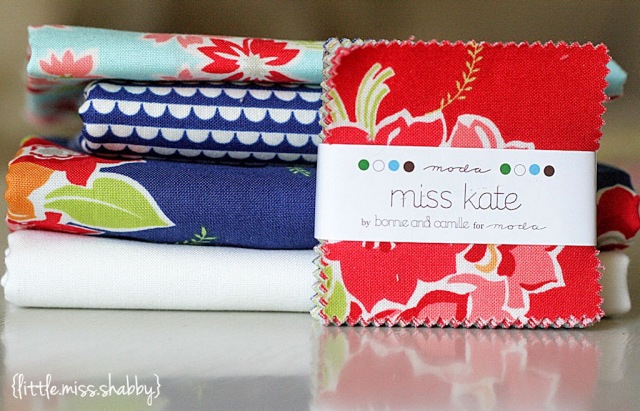

1 Mini Charm Pack – Print / Chance of Flowers
2 Mini Charm Packs – Solid / Bella Solid in Snow
3 Coordinating Fat Quarters
21″ Pillow Form

22″ Square of batting for quilting the pillow top
22″ Square of scrap fabric or muslin

Pull 40 printed charms and 64 solid charms.
Pair up 40 prints with 40 solids, right sides facing. Finger press a a diagonal crease on one side.
Chain stitch the 40 pairs of prints and solids on the diagonal crease.
Optional:
Without breaking the chain, run the the charms back through and stitch a 1/2″ over. Rather than throwing the trimmed fabric away, this quick step will create 40 little HST’s for future projects.
Cut. The pictures below show both options.
Open and press.
You should have a stack of 40 Half Square Triangles (HST) and 24 Solids.
Layout:
Using 12 HST’s and 4 solids, create a star.
Add the next row around – double check to make sure your HST’s are going in the right direction.
Add the points on the top and bottom.
Fill in with the remaining solid charms.
Piece:
Feel free to use your preferred method, I’ll show mine.
Some people like to stitch from the inside out, others in rows or even quadrants. This is how I piece several small squares that I want to keep in a certain layout and direction.
Going in vertical rows: Fold the squares on the right column onto the squares on the left.
Chain stitch – do not cut the thread between squares.
Feel free to press the seams, I don’t find it necessary and I will press later on.
Using the set of chained pairs, fold the first two pairs right sides together and stitch. Open. Fold the next pair up onto the previous pair and stitch. Repeat until all 8 pairs are pieced together.
Leaving them chained is nice because they stay in the right order and direction.
Open and press the seams all in one direction. When you complete the next row, press those seams in the opposite direction. This will make it easier to piece the rows together.
Stitch the two completed rows together.
Stitch the other two rows using the same method, and sew the halves together.
If your edges are raggedy, feel free to trim a little and straighten them out. Just be careful not to cut off the HST points along the edge and leave a seam allowance.
Take a Fat Quarter and cut four 2.5″ strips down the length of the fabric. You will have four strips approximately 21″ wide.
Attach one strip to the top and one to the bottom of your block.
Press open and trim.
Attach the other two strips to the sides.
Press open and trim.
Optional: Using the batting and scrap fabric, quilt as desired. Trim.

Double fold:
Take your remaining 2 Fat Quarters and along the 21″ side, fold over 1″ and press. Fold over another 1″ and press.
Top stitch along the top and bottom of the fold. Repeat with the other Fat Quarter.
The Math:
The two back pieces will create an envelope style enclosure and they need to overlap about 4″. Since everyone sews 1/4″ seams a bit different, we may have slightly different sized pillow tops.
Take the width of your pillow top and divide by 2.
Add 2″.
You should be somewhere near 12″.
Trim both Fat Quarters to that measurement. Trim the raw edge opposite your double edge fold, leaving the 21″ width intact.
Example: My pillow top is 20″. 20 divided by 2 = 10. Add 2 = 12″. I now have two fat quarters that measure 21″ x 12″ each. (21″ side has the double fold)
Part 2:
Trim both Fat Quarters so they don’t hang off pillow top. Instead of being 21″ they will probably around 20″.

Layer:
Pillow Top right side up
Fat Quarter #1 right side down – lining up raw edges along the side
Fat Quarter #2 right side down – lining up raw edges along the opposite side
Pin or clip edges in place. Stitch along the edge all the way around.
Zip Zag or Serge the seam you created. This will help prevent fraying in the future.
Turn right side out and you are done!
I’m using a 21″ pillow form.

One pillow cover. If you make a Candy Flowers pillow cover, I would love to see it.
Julie Hirt
{627handworks.com}

![]()
























































































































